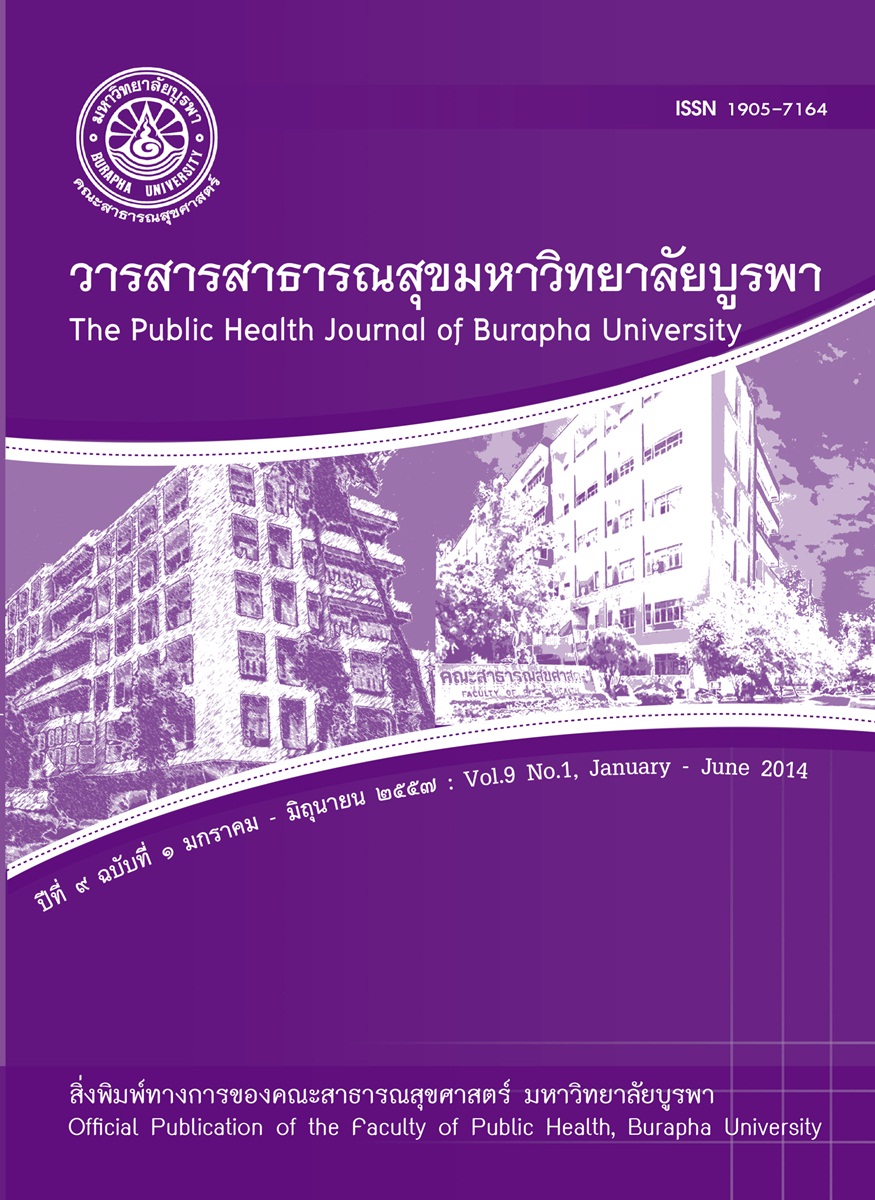การศึกษาเปรียบเทียบประสิทธิภาพการลดนำ้หนักกากตะกอนน้ำเสีย โดยการใช้พัดลม พัดลมร้อน และหลังคาโปร่งแสง ในโรงงานอุตสาหกรรมยานยนต์ Comparative efficiency study for weight reduction of wastewater sludge by fan, heat fan, and translucent roof in auto indust
Main Article Content
บทคัดย่อ
การศึกษาครั้งนี้มีวัตถุประสงค์เพื่อ 1) เปรียบเทียบประสิทธิภาพในการลดน้ำหนักกากตะกอนน้ำเสียโดยใช้วิธีพัดลม พัดลมร้อน และหลังคาโปร่งแสง และ2) ศึกษาปัจจัยเรื่อง ความชื้นก่อนการทดลอง สภาพอากาศ และความชื้นสัมพัทธ์อากาศที่มีผลต่อการลดน้ำหนักกากตะกอนน้ำเสีย ของโรงงานอุตสาหกรรมยานยนต์ โดยการเก็บตัวอย่างกากตะกอนน้ำเสียจากลานตากกากตะกอนน้ำเสียและนำมาทำการทดลองทั้งสิ้น 8 งวด ในช่วงเวลา 3 เดือนตั้งแต่เดือนมีนาคม-พฤษภาคม 2556 และนำผลการทดลองมาวิเคราะห์โดยใช้สถิติ T-test และ ANOVA ที่ระดับนัยสำคัญทางสถิติ 0.05 จากการศึกษาพบว่า วิธีใช้หลังคาโปร่งแสงใหม่มีประสิทธิภาพในการลดน้ำหนักกากตะกอนได้มากที่สุด เฉลี่ยร้อยละ 55.41 มีประสิทธิภาพดีกว่าวิธีเดิม คือการตากโดยหลังคาโปร่งแสงเก่า(ที่มีการใช้งานมามากกว่า 5 ปี) เฉลี่ยร้อยละ 13 รองลงมาเป็นการใช้พัดลมธรรมดา มีประสิทธิภาพในการลดน้ำหนักกากตะกอนน้ำเสียเฉลี่ยร้อยละ 52.49 ประสิทธิภาพดีกว่าวิธีเดิมร้อยละ 10 และการทดสอบสมมติฐานพบว่าระดับความเร็วลมของพัดลมไม่มีผลต่อประสิทธิภาพการลดน้ำหนักกากตะกอนอย่างมีนัยสำคัญทางสถิติ ที่ระดับ 0.05 และการใช้พัดลมร้อนมีประสิทธิภาพในการลดน้ำหนักกากตะกอนน้ำเสียได้เฉลี่ยร้อยละ 45.26 ประสิทธิภาพมากกว่าวิธีเดิมร้อยละ 3 และจากการทดสอบสมมติฐานพบว่าระยะเวลาให้ความร้อนของพัดลมที่ระยะเวลาที่แตกต่างกัน ไม่มีผลต่อประสิทธิภาพการลดน้ำหนักกากตะกอนน้ำเสียอย่างมีนัยสำคัญทางสถิติ ที่ระดับ 0.05 สำหรับปัจจัยที่มีผลต่อการลดน้ำหนักกากตะกอนน้ำเสีย พบว่าปัจจัยเรื่อง ความชื้นตะกอนก่อนตาก สภาพอากาศและความชื้นสัมพัทธ์อากาศระหว่างการทดลอง ต่างมีผลต่อประสิทธิภาพการลดน้ำหนักกากตะกอนน้ำเสียอย่างมีนัยสำคัญทางสถิติ ที่ระดับ 0.05
The objectives of this study were 1) to compare efficiency in weight reducing of wastewater sludge by fan, heat fan, and translucent roof and 2) to explore factors that affected weight reducing of wastewater sludge. In this study, 8 batches of wastewater sludge samples were taken from sludge bed for three months from March to May 2013. Data were analyzed by T-test and ANOVA at significant level of 0.05. The results showed that the new translucent roof gave the highest efficiency in weight reducing about 55.41 percent that was higher than those of the former method – using an old translucent roof (had been used for more than 5 years) for about 13 percent, following by the use of fan that gave the efficiency in weight reducing of wastewater sludge about 52.49 percent that was higher than the former method for about 10 percent. In addition, it was found that different wind speeds did not give different weight reducing of the sludge. Finally, the heat fan gave the efficiency of 45.26 percent that was higher than the former method of about 3 percent. Moreover, it was found that different times to dry by heat fan did not give different weight reducing of the sludge for a significant level of 0.05. Factors affecting weight reduction of the sludge included moisture of waste water sludge before drying, different drying seasons, and relative humidity.

